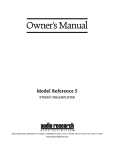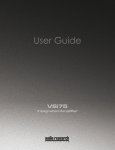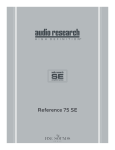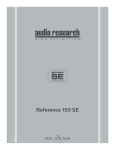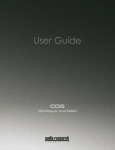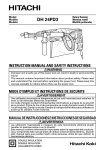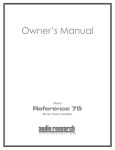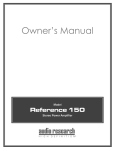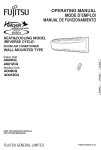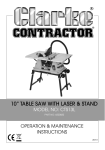Download Audio Research Reference 750 Owner`s manual
Transcript
Owner’s Manual Reference 750 Monaural Amplifier Contents Reference 750 Monaural Amplifier Illustrations 3 – 4 Preface 5 Packaging 5 Accessories 5 Vacuum Tubes and Preparation for Use 5 Installation 5 – 6 Warnings 6 Description of Controls 6 – 7 Connections 7 – 8 Operating Procedure 8 Installation of Optional Cover 8 Servicing 9 Cleaning 9 Disposal and Recycling Guidelines 9 Limited Warranty 9 Specifications 10 2 POWER OUTPUT/BIAS V15 V1 V13 V11 CHECK V3 V5 V9 V10 V7 V8 CHECK V12 V14 CHECK V6 V4 V16 V2 CHECK SET SET FAN LIGHT BIAS METER LINE VOLTAGE POWER VACUUM TUBE POWER AMPLIFIER REFERENCE 750 HIGH DEFINITION 3 R INPUT 200K BAL HOUR METER RESET REFERENCE 750 MONAURAL AMPLIFIER PLYMOUTH, MINNESOTA MADE IN U.S.A. CAUTION RISK OF ELECTRIC SHOCK DO NOT OPEN ! WARNING TO PREVENT FIRE AND SHOCK HAZARD, DO NOT EXPOSE THIS DEVICE TO RAIN OR MOISTURE. UNIT MUST BE OPERATED IN A HORIZONTAL POSITION. -DO NOT OPERATE WITH COVERS REMOVEDUNIT CONTAINS VOLTAGES WHICH MAY BE HAZARDOUS. WARNING CAUTION RISK OF HAZARDOUS ENERGY! MAKE PROPER SPEAKER CONNECTIONS SEE OWNERS MANUAL. FOR CONTINUED PROTECTION AGAINST FIRE HAZARD REPLACE FUSE ONLY WITH SAME TYPE AND RATING SERIAL VOLTS + + 8 16 4 8 16 4 ~ 2200W MAX 50/60 HZ 20A FUSE SLO-BLO 10A (240V) - - + - 4 Preface Please take time to carefully read and understand the following information and instructions before you install or attempt to operate your Audio Research Reference 750 vacuum tube monoblock power amplifier. Becoming familiar with important facts about your amplifier and its correct operating procedures will help assure maximum musical satisfaction and reliable operation. Packaging Save all packaging accompanying this product. You have purchased a precision electronic instrument, and it should be properly cartoned any time shipment becomes necessary. It is very possible that this unit could be damaged during shipment if repackaged in cartoning other than that designed for it. The original packaging materials help protect your investment from unnecessary damage, delay and added expense whenever shipment of this unit is required. See separate ‘Unpacking/Repacking Instructions’ card attached to the outer amplifier carton before attempting to unpack or repack this amplifier for shipment. Retain unpacking/repacking instructions for future reference. Accessories 1 – Phillips-head screwdriver for panel removal. 1 – Plastic screwdriver for front panel potentiometer bias adjustment. Fuses 1 – 2 Amp MDQ slo-blo for LV power transformer in 120V units. 1 – T1 Amp fast-blo for LV power transformer in 220, 240V units. 1 – 4 Amp MDQ slo-blo for start-up circuit in 120V units. 1 – T3.15 Amp fast-blo for start-up circuit in 220, 240V units 1 – 20 Amp MDA for main power in 120V units. 1 – 10 Amp MDA for main power in 220, 240V units. CAUTION: When replacing fuses, use ONLY the value and type of fuse originally shipped with the amplifier. Use of a different fuse value could cause catastrophic damage to your amplifier and will also void your warranty. Audio Research selects fuses not only on grounds of safety but also for their sonic performance. 5 Vacuum Tubes and Preparation for Use Do not attempt to operate this amplifier before installing the necessary vacuum tubes in their indicated sockets. The tubes are protectively packed in a separate carton; save packing for possible future use. 1. All input, driver and output-stage tube locations are clearly labeled with tube type and “V” number on the anodized plate covering the top of the amplifier. There is one 6H30 input tube, two KT120 drivers, and 16 KT120 output tubes. In addition, two power-supply regulator tubes–one 6H30 and one 6550 – are located inside on the upper or second-level circuit board. To access this location, use the supplied Phillips-head screwdriver to remove all fastening screws on one of either of the two side panels; the tube sockets will be visible near the center of the board. 2. Match each tube's ‘V’ number marked on the tube with the ‘V’ number of the corresponding socket. Insert tubes by carefully aligning tube pins with socket holes and gently applying downward pressure. The base of the tube should firmly contact the surface of the socket. Once the power-supply tubes have been installed inside the amplifier, refasten the side panel and proceed to install the tubes on top of the amplifier. 3. Note: In general, contact enhancers are not recommend for use on vacuum tube contact pins. With continual exposure to heat and air, many of these substances can form gummy, dustcollecting residues which actually reduce contact and degrade sonic performance. Proper external use of these preparations – on interconnect plugs, speaker connections, etc.– is subject to the discretion of the owner. Contact Audio Research for specific recommendations. Installation To insure normal component life and safe operation this unit must be operated only in an upright position. Adequate air flow and proper cooling can occur only if there is no restriction above the unit and on either side. The special non-marring elastomer feet provide adequate spacing and stability only on a smooth, hard surface. For upright stability, never operate the unit while it is sitting on a soft surface such as a thick rug or carpet. Due to its unusually high weight, this amplifier must be supported on a surface specifically rated for such a load. Standard furniture cabinetry and shelving are not typically designed to adequately support this amplifier. Check with the manufacturer of your support system to be sure it is rated to handle this weight. If the unit is to be operated in an enclosure such as an equipment rack, make certain that adequate air flow above and to each side of the unit is provided. The “ambient” operating temperature should never exceed 120º F or 49º C. Additional ventilation can be provided by fan-cooled, perforated tube covers available for purchase through your Audio Research dealer. If these covers are used, do not place paper, wood, or any other objects on top of the cover that could obstruct cooling or create a fire hazard. Improper installation will cause premature tube failure and will affect your warranty, as well as the service life of the unit. Keep children and pets away from exposed tubes at all times to prevent possible burns or injury. It is normal for a vacuum tube power amplifier to run quite “warm”, and if used for prolonged periods, “hot” to the touch. All components within are, however, operated at safe, conservative levels and will not be improperly affected thereby, providing the requirements outlined above are adhered to. Warnings 1. To prevent fire or shock hazard, do not expose this product to rain or moisture. 2. This unit operates on voltages which can cause serious injury or death. Do not operate with top cover or side panels removed. Any necessary servicing should be carried out by your authorized Audio Research dealer or other qualified electronics technician. 3. Use only the plastic insulated screwdriver included with this unit when making front panel bias adjustments. 4. The power cord on this unit is safety-tested and is equipped with a proper grounding plug. If used normally, it will provide a safe earth ground connection of the chassis. Defeat of the grounding plug, or any unauthorized modification of the active circuitry or controls of this unit, automatically voids warranty coverage, 5. For safe operation and protection against fire hazard, replace fuses only with those of the same type and rating as those supplied with this unit. 6. At 170 lbs. (77.2 Kg) net weight per chassis, the Reference 750 amplifier is too heavy for one person to lift. To avoid injury, do not attempt to unpack, lift or move the unit without the help of at least one other person. 7. Always mute the preamplifier when cueing a phono cartridge stylus up or down. Due to the immense power supply reserves, high power output, and wide bandwidth of the Reference 750, added emphasis must be placed on use of your preamplifier's mute switch from a safety standpoint. A transient signal burst or “pop” such as caused by tonearm cueing, accidental dropping or brushing of the phono cartridge stylus– even at a normal listening level–could cause an instantaneous peak power demand on the amplifier of up to 1000 watts (which the Reference 750 will try to deliver). The importance of lowering the preamplifier volume level to a minimum setting and activating the mute switch whenever cueing the tonearm or making contact with the phono cartridge stylus cannot be overemphasized. Adhering to this precautionary muting procedure is equally important when turning your system on or off, and when connecting or disconnecting any cables in the system. Carefully following this recommendation will minimize the chance of causing undue stress and potential damage to your amplifiers and loudspeakers. (See your preamplifier Owner's Manual for more detailed instructions on use of muting provisions.) Description of Controls POWER: Press the POWER switch to turn the unit on, indicated by a lit green LED directly above the switch. When turned on, there is an automatic warm-up sequence which lasts for approximately 45 seconds before the unit is operational. FAN: Press the FAN switch to select low (dim Power LED) or high (bright Power LED) for fan speed setting. Only applicable to installed optional top cover with ventilation fans. LIGHT: Press the LIGHT switch to select high, low, or no meter illumination. BIAS (Adjustment Procedure): NOTE: Amplifier should be turned on and operating for at least 30 minutes prior to adjusting bias of the output tubes. Press BIAS switch once and the V1 output tube LED is illuminated with its bias level indicated on the front panel meter. Adjust V1 tube bias level with the plastic flat-bladed bias tool (provided), inserted in the V1 SET hole in the front panel so the meter reading is in the center of the labeled bias range. Press BIAS switch again to check V3 tube bias level which should be within the bias range arc. Press the BIAS switch repeatedly and check the V5, V7, V9, V11, V13 and V15 tube bias levels in the same way. Note that each of the odd V number the tube bias levels are controlled by the V1 bias setting. Press the BIAS switch once more to read and adjust V2 tube bias level with the bias tool in the V2 SET 6 hole in the front panel in same way the V1 tube bias level is adjusted. Again, press the BIAS switch repeatedly to check V4, V6, V8, V10, V12, V14 and V16 tube bias levels, which should all be within the bias range arc. Note that each of the even V number tube bias levels are controlled by the V2 bias setting. Note that the corresponding V number LED is illuminated for each output tube as you proceed through the bias adjustment and monitoring sequence. Press BIAS switch a final time to exit the bias status function and return the meter to the power level monitoring function. The Reference 750 is shipped from the factory with all tubes properly biased and ready to use. It is not necessary to check bias each time the amplifier is turned on. Under typical circumstances, most owners will find that checking the bias level once a month or so will insure proper operation and good service life of the output tubes. Audio Research-supplied output tubes are warranted for 90 days, and under normal conditions should provide up to 2000 hours of service life. This expected life will vary depending on conditions of use–ventilation, speaker loads, average playing level and A. C. voltage and line condition. Complete sets of replacement tubes or individual tubes are available from Audio Research, and are strongly recommended for best sonic performance and reliability. These tubes are burned in, measured, matched and specifically selected for your Audio Research amplifier. Contact your authorized dealer for suggested retail prices. METER: Press METER button to turn on or of the power level monitoring meter function. NOTE: The FAN, LIGHT and METER settings at turn off are retained each time the amplifier is turned on. Connections INPUT CONNECTOR: The Reference 750 uses a fully balanced circuit topology and thus has one balanced XLR input connector on the rear panel. It therefore requires a balanced preamplifier output, as provided by most Audio Research preamplifiers. Connect your preamplifier's output to the Reference 750 before turning on the amplifier. OUTPUT CONNECTORS: Proprietary, heavy-duty output terminals are provided on the rear panel for 4, 8,or 16-ohm speaker impedance loads. Using high-quality speaker cables, securely fasten the (-) speaker lead to the appropriate (-) terminal, then the (+) lead to the matching (+) terminal, following your speaker manufacturer's impedance specification. The Reference 750 puts out the same amount of power whether the 4, 8 or 16-ohm 7 terminals are used, provided the speaker and amplifier terminal impedances are matched. IMPORTANT: Use the best available speaker wires and interconnects. Audio Research cannot emphasize this enough. As better components and systems are developed, it becomes increasingly important to avoid the limitations of inferior system interconnections. It is important sonically that your entire system be connected so that the audio signal arriving at the speakers has correct, or “absolute” polarity (i.e., non-inverted). Connect the black or “-” speaker terminal to the wire that connects to the “0” terminal on the Reference 750. Connect the red or “+” speaker terminal to the wire that connects to the “4” or “8” terminal on the Reference 750 and tighten the speaker terminals securely to ensure best sonic results. MATCHING: It is important to use as close as possible an impedance match between the amplifier and speaker for optimum transfer of power to the speaker with minimum distortion. In the case of speaker systems with significant variations in impedance throughout the frequency spectrum, such as most electrostatic types, determine the best impedance match empirically for best overall sonic results. Connect the Reference 750 input to the preamplifier or electronic crossover, using only the highest grade of audio interconnect cables. To avoid sonic degradation use the shortest practical length of cables. A.C. POWER CONNECTIONS: It is important that the Reference 750 be connected via its supplied 20 amp IEC 12-gauge power cord to a secure, dedicated A.C. power receptacle. Never connect to convenience power receptacles on other equipment. Only use the power switch on the front of the Reference 750 for On/Off control of the amplifier, or the 12V start-up trigger for remote installations. The A.C. power source for the Reference 750 should be capable of supplying 20 amperes for 120V units, or 10 amperes for 220/240V units. Preferably, the amplifier should be connected to its own A. C. power circuit branch, protected by a 20-30 amp circuit breaker. The preamplifier and other related equipment should be connected to a separate power circuit and breaker. If the power receptacle is more than 25 feet from the building's power entrance and breaker box, circuit wiring capable of 30 amperes should be installed to minimize voltage drop using a 20-amp breaker. Avoid the use of extension cords. If they must be used on a temporary basis, use 12-gauge cords or heavier. The Reference 750 should be turned on after the other components of your system. If the Reference 750 is turned on before other components, the amplifier will amplify any extraneous turn-on noises those components might generate, which could potentially damage the loudspeakers. Good operating practice dictates that the amplifier should be turned on last, and turned off first in an audio system. The Reference 750 uses a grounding system that does not require a ground-lifter adaptor plug on the A. C. power cord to minimize hum. The power cord supplied with the Reference 750 has a standard grounding plug to provide maximum safety when properly connected to a grounded wall receptacle. If there is any question regarding proper grounding procedures in your installation, seek help from a qualified technician. Caution should be taken before using custom after-market power cords: they must be at least 12-gauge and have a standard grounding plug properly installed. These power cords are to be used with caution, at the sole risk of the owner. If electronic crossovers or other AC powered equipment is used with the Reference 750 it may be necessary to use “ground lifter” adapters on the power plugs of that equipment to minimize system hum. Generally, the lowest hum is achieved when the only direct connection between audio common “ground” and true earth ground occurs in the preamplifier, through its grounded power cord. Other equipment in the system should have some form of isolation to prevent ground loops and associated hum. NOTE: Once you have turned off the amplifier, please allow at least five minutes for the power supply to discharge before turning the amplifier on again. Turning on tany tube amplifier immediately following a turn off could shorten the life of your vacuum tubes or cause tube failure. Installation of Optional Cover To install the optional fan-cooled tube cover, first align the front of the cover with the top front edge of the amplifier, making sure the fans are positioned at the rear. Note that there are five holes along the top edge of each side panel; these should match up with corresponding holes along the bottom side edges of the tube cover. Before settling and aligning the tube cover at the rear, insert the 12V D.C. plug attached to the fans into the 12V socket located at the back edge of the anodized top plate. Then secure and align the tube cover completely, insert supplied screws and tighten moderately. Operating Procedure Start-Up: 1. Secure input connection between the amplifier and your preamplifier; attach speaker leads to the appropriate output terminals. 2. Attach supplied power cord to rear IEC inlet of amplifier, and plug other end into grounded A. C. power receptacle. 3. Turn on preamp and input source components; mute preamp output. 4. Press Reference 750 front panel power switch to turn unit on; a 45 second mute/warm-up cycle will follow. 5. Unmute preamplifier output, initiate source component signal, and adjust gain as appropriate. Shut-Down: 1. Mute preamplifier output. 2. Press Reference 750 front panel switch to turn unit off 3. Turn off preamplifier and then the associated input source components. 8 Servicing Limited Warranty Because of its careful design and exacting standards of manufacture, your Reference 750 amplifier should normally require only minimal service to maintain its high level of performance. CAUTION: The Reference 750 amplifier contains sufficient levels of voltage and current to be lethal. Do not tamper with a component or part inside the unit. Even with the power turned off, a charge remains in the energy storage capacitors for some time. Refer any needed service to your authorized Audio Research dealer or other qualified technician. Additional questions regarding the operation, maintenance or servicing of your amplifier may be referred to the Customer Service Department of Audio Research Corporation at 763-577-9700 (CST). When ordering a service manual from Audio Research or an authorized dealer, be sure to identify the serial number on your amplifier. Audio Research Corporation products are covered by a 3-Year Limited Warranty or a 90-Day Limited Warranty (vacuum tubes). This Limited Warranty initiates from the date of purchase, and is limited to the original purchaser, or in the case of demonstration equipment, limited to the balance of warranty remaining after original shipment to the retailer or importer. In the United States, the specific terms, conditions and remedies for fulfillment of this Limited Warranty are listed on the warranty card accompanying the product in its shipping carton, or may be obtained from the authorized retailer or from the Audio Research Customer Service Department. Outside the United States, the authorized importing retailer or distributor has accepted the responsibility for warranty of Audio Research products sold by them. The specific terms and remedies for fulfillment of the Limited Warranty may vary from country to country. Warranty service should normally be obtained from the importing retailer or distributor from whom the product was purchased. In the unlikely event that technical service beyond the ability of the importer is required, Audio Research will fulfill the terms and conditions of the Limited Warranty. Such product must be returned at the purchaser's expense to the Audio Research factory, along with a photocopy of the dated purchase receipt for the product, a written description of the problem(s) encountered, and any information necessary for return shipment. The cost of return shipment is the responsibility of the purchaser. Cleaning To maintain the new appearance of this amplifier, occasionally wipe the front panel and top cover with a soft, damp (not wet) cloth to remove dust. A mild, non-alkaline soap solution may be used to remove fingerprints or similar smudges. Cleaners containing abrasives should not be used as they will damage the anodized finish of the front panel. A small, soft paint brush is effective in removing dust from bevels, the recessed nameplate and other features of the front panel. Disposal and Recycling Guidelines To dispose of this electronic product, do not place in landfill. In accordance with the European Union Waste Electrical and Electronic Equipment (WEEE) directive effective August 2005, this product may contain regulated materials which upon disposal require special reuse and recycling processing. Please contact your dealer or importing distributor for instructions on proper disposal of this product in your country. Or, contact Audio Research Corporation (763-577-9700) for the name of your importing distributor and how to contact them. Packing and shipping materials may be disposed of in a normal manner. 9 Specifications POWER OUTPUT: 750 watts per channel continuous from 20Hz to 20kHz. 1kHz total harmonic distortion typically 0.5% at 750 watts, below .04% at 1 watt. Approximate actual power available at “clipping” 850 watts (1kHz). (Note that actual power output is dependent upon both line voltage and “condition” i.e.: if power line has high distortion, maximum power will be affected adversely, although from a listening standpoint this is not very critical.) POWER BANDWIDTH: (-3dB points) 15Hz to 150kHz. FREQUENCY RESPONSE: (-3dB points at 1 watt) 1 Hz to 200 kHz. INPUT SENSITIVITY: 4.6V RMS Balanced for rated output. (24 dB gain into 8 ohms.) INPUT IMPEDANCE: 200K ohms Balanced. OUTPUT TAPS: 4, 8, 16 ohms. OUTPUT REGULATION: Approximately 0.5dB 16 ohm load to open circuit (Damping factor approximately 17). OVERALL NEGATIVE FEEDBACK: 13dB. SLEW RATE: 20 volts/microsecond. RISE TIME: 1.5 microseconds. HUM & NOISE: Less than 0.2mV RMS – 110dB below rated output (IHF-A weighted, input shorted, 16 ohm output). POWER SUPPLY ENERGY STORAGE: Approximately 1300 joules. POWER REQUIREMENTS: 105-130VAC 60Hz (200-270VAC 50Hz) 2100 watts at rated output, 2400 watts maximum, 800 watts at “idle”. TUBES REQUIRED: 8 Matched pair KT120 Power Output; 1 6550WE Regulator; 1 6H30 Regulator Amplifier; 1 matched pair KT120 Driver; 1 6H30 follower. DIMENSIONS: 13.5" (34.3 cm) W x 23" (58.4 cm) H x 20.8" (52.8 cm) D. Handles extend 1.5" (3.8 cm) forward and rearward. WEIGHT: 170 lbs. (77.2 kg) Net; 395 lbs. (180 kg) per pair shipped weight. Specifications subject to change without notice. ©2011 Audio Research Corporation. 3900 Annapolis Lane North Plymouth, MN 55447 (763) 577-9700 10











